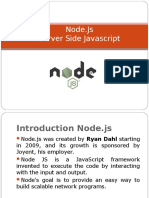0% found this document useful (0 votes)
44 views25 pagesUnit 3 (Node - Js & Express - JS)
Node.js is an open-source runtime environment that allows JavaScript to run on the server side, featuring a non-blocking I/O model and a package manager called NPM. Express.js is a web application framework for Node.js that simplifies server-side development with features like routing and middleware support. Together, they enable developers to create efficient, scalable web applications and APIs with ease.
Uploaded by
2203031050417Copyright
© © All Rights Reserved
We take content rights seriously. If you suspect this is your content, claim it here.
Available Formats
Download as PDF, TXT or read online on Scribd
0% found this document useful (0 votes)
44 views25 pagesUnit 3 (Node - Js & Express - JS)
Node.js is an open-source runtime environment that allows JavaScript to run on the server side, featuring a non-blocking I/O model and a package manager called NPM. Express.js is a web application framework for Node.js that simplifies server-side development with features like routing and middleware support. Together, they enable developers to create efficient, scalable web applications and APIs with ease.
Uploaded by
2203031050417Copyright
© © All Rights Reserved
We take content rights seriously. If you suspect this is your content, claim it here.
Available Formats
Download as PDF, TXT or read online on Scribd
/ 25

















































































